story by Kayte Deioma, photos Š SSPI 2005 David Allen
In the beginning there was sand, a lifeguard and some middle aged hula dancers in a back room at the Savoy Tivoli Restaurant. Thirty-three years later the sand and lifeguards are gone, but the name stuck on the ever-changing panoply of characters and grand millinery that calls itself Beach Blanket Babylon. Within its first year in 1974, the show moved to its current digs at Club Fugazi in North Beach where it still plays to a full house for eight shows a week.
What gives Steve Silver’s little musical review such staying power? In part, it’s the quirky way the show matches itself to the character of its home town of San 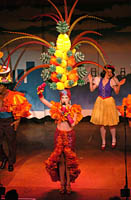 Francisco. But much of its longevity can also be attributed to constantly being reinvented to reflect the news of the day. Many long time fans see the show over and over again because the spoofs change from month to month, and because there are always new and bigger hats.
Francisco. But much of its longevity can also be attributed to constantly being reinvented to reflect the news of the day. Many long time fans see the show over and over again because the spoofs change from month to month, and because there are always new and bigger hats.
The premise of the show is that home-girl Snow White, played by Shawna Ferris, is looking for her prince, but having a hard time finding him in San Francisco. Enter Renee Lubin as Glinda the Good, a fairly godmother type who sends her off on a round-the-world trip in search of Mr. Right. Along the way she runs into a host of celebrity and political figures parodying your favorite songs from the last five decades. The characters are distinguishable by their gaudy costumes, huge hair and giant hats – from the Carmen Miranda pineapple extravaganza to a grand San Francisco Skyline chapeau that wears Val Diamond, rather than being worn by her.
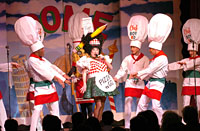 Diamond, a 27 year veteran of the show, plays a bevy of characters from Rome to Japan and back to San Francisco, belting out classic tunes to fit the moment. In Rome she is a pizza waitress with a giant order pad and pencil on her head dancing with the Chef Boy R D Chefs singing That’s Amore. She’s a Maid in Japan, a Cowgirl and a Jewish Mother. In Paris she entreats Snow White to drop the good girl persona and get trashy as she does the cancan with a bunch of dancing trash cans.
Diamond, a 27 year veteran of the show, plays a bevy of characters from Rome to Japan and back to San Francisco, belting out classic tunes to fit the moment. In Rome she is a pizza waitress with a giant order pad and pencil on her head dancing with the Chef Boy R D Chefs singing That’s Amore. She’s a Maid in Japan, a Cowgirl and a Jewish Mother. In Paris she entreats Snow White to drop the good girl persona and get trashy as she does the cancan with a bunch of dancing trash cans.
Between appearances as Glinda the Good, Renee Lubin returns as an Italian Oprah, complete with book club on her head; Janet Jackson with a wardrobe malfunction; a blue-clad blues singer with a dynamite version of Ain’t Misbehavin’; and Tina Turner with a wig that looks like she’s wearing Cousin Itt from the Addams Family on her head.
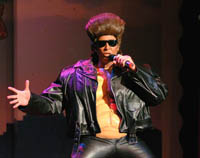 The Monica Lewinsky character has been written out of the show, but Hilary Clinton puts in an appearance as the Statue of Liberty singing You Done Me Wrong while Bill Clinton hangs out with Paris Hilton and the Governator shows up on crutches. A big-eared G.W. Bush appears with a gun-toting Cheney and Condaleezza Rice-a-Roni-head to the tune of Annie Oakley’s You Can’t “Shoot” a Man with a Gun. The political spoof of the week is Speaker of the House Nancy Pelosi as a biker chick in leather toLeader of the Pack.
The Monica Lewinsky character has been written out of the show, but Hilary Clinton puts in an appearance as the Statue of Liberty singing You Done Me Wrong while Bill Clinton hangs out with Paris Hilton and the Governator shows up on crutches. A big-eared G.W. Bush appears with a gun-toting Cheney and Condaleezza Rice-a-Roni-head to the tune of Annie Oakley’s You Can’t “Shoot” a Man with a Gun. The political spoof of the week is Speaker of the House Nancy Pelosi as a biker chick in leather toLeader of the Pack.
Some characters, like John Travolta and the Beatles hang around long enough for a song or two. Others, like Ashton and Demi on a tricycle, Tom Cruise, Katie and their alien baby, and the Brokeback Mountain cowboys tucked in giant jeans pockets, appear just long enough for a laugh.
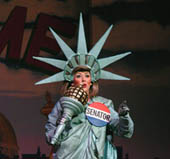 There are probably 90 bits in 90 minutes, leading up to the ultimate makeover by the Queer Eye for the Straight Guy boys and a happily-ever-after wedding-cake-hat ending. Through all the camp and kitsch, the cast give really stellar performances. All the singers are top notch, but Diamond and Lubin really carry the show.
There are probably 90 bits in 90 minutes, leading up to the ultimate makeover by the Queer Eye for the Straight Guy boys and a happily-ever-after wedding-cake-hat ending. Through all the camp and kitsch, the cast give really stellar performances. All the singers are top notch, but Diamond and Lubin really carry the show.
Club Fugazi is set up cabaret style with cocktail tables on the main floor and balcony. Wine, beer and non-alcoholic beverages are available for purchase (cash only). Performances are Wednesday through Sunday. You must be 21 or older to attend any of the evening shows. People under 21 are welcome at the Sunday matinees when no alcohol is served. The theatre opens an hour before the show.
Beach Blanket Babylon
Club Fugazi
678 Green Street
San Francisco, CA
www.beachblanketbabylon.com

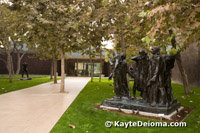 A visit to the Norton Simon begins before you even enter the building. The walkway from the parking lot traverses a garden of larger-than-life Rodin sculptures. The centerpiece of these sculptures is the Burghers of Calais, a sculpture of six men in ragged clothing with nooses around their necks. It was commissioned by the city of Calais to commemorate the brave act of these men in hostaging themselves to the King of England in order to gain freedom for their town in 1347. Before creating the final sculpture of the six men, August Rodin created studies of each individual nude and then clothed. Some of these full-size studies surround the Burghers of Calais in the front garden.
A visit to the Norton Simon begins before you even enter the building. The walkway from the parking lot traverses a garden of larger-than-life Rodin sculptures. The centerpiece of these sculptures is the Burghers of Calais, a sculpture of six men in ragged clothing with nooses around their necks. It was commissioned by the city of Calais to commemorate the brave act of these men in hostaging themselves to the King of England in order to gain freedom for their town in 1347. Before creating the final sculpture of the six men, August Rodin created studies of each individual nude and then clothed. Some of these full-size studies surround the Burghers of Calais in the front garden.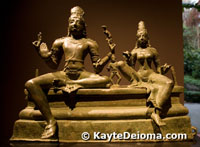 Inside, the Museum is divided into two levels. The main level or upper level houses European and American paintings and sculptures from the 14th century to the 20th century. Downstairs is Norton Simon’s extensive collection of South and Southeast Asian Art, which consists primarily of sculptures and architectural elements from India, Thailand, Cambodia, Tibet and other parts of Southeast Asia with just a few works on paper. The temporary exhibit hall is also downstairs.
Inside, the Museum is divided into two levels. The main level or upper level houses European and American paintings and sculptures from the 14th century to the 20th century. Downstairs is Norton Simon’s extensive collection of South and Southeast Asian Art, which consists primarily of sculptures and architectural elements from India, Thailand, Cambodia, Tibet and other parts of Southeast Asia with just a few works on paper. The temporary exhibit hall is also downstairs.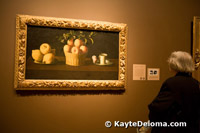 The beauty of the Norton Simon is that you can see virtually every important European artist from the Old Masters to the Impressionists and post-Impressionists all within a few steps of each other. Earlier works on display include Raphael’s Madonna and Child with Book (c.1502-3), Francisco de Zurburan’s Still Life with Lemons, Oranges and a Rose (1633) and Rembrandt van Rijn’s Portrait of a Boy, Presumed to Be the Artist’s Son, Titus (c. 1645-50).
The beauty of the Norton Simon is that you can see virtually every important European artist from the Old Masters to the Impressionists and post-Impressionists all within a few steps of each other. Earlier works on display include Raphael’s Madonna and Child with Book (c.1502-3), Francisco de Zurburan’s Still Life with Lemons, Oranges and a Rose (1633) and Rembrandt van Rijn’s Portrait of a Boy, Presumed to Be the Artist’s Son, Titus (c. 1645-50).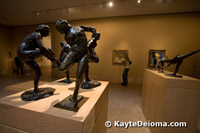 In the popular Impressionists exhibit, you can see Matisse, Renoir, Van Gogh, Manet, Monet, Toulouse-Lautrec, Cezanne and Degas side by side, with multiple examples of each. Vincent van Gogh’s Mulberry Tree is one of the more famous works in the collection, along with the Degas‘ sculpture, Little Dancer, Aged Fourteen (1878-81). The museum has one of the largest collections of works by Edgar Degas, with over 100 paintings, drawings, statues and bronze modčles that the artist used as studies for his dancer figures.
In the popular Impressionists exhibit, you can see Matisse, Renoir, Van Gogh, Manet, Monet, Toulouse-Lautrec, Cezanne and Degas side by side, with multiple examples of each. Vincent van Gogh’s Mulberry Tree is one of the more famous works in the collection, along with the Degas‘ sculpture, Little Dancer, Aged Fourteen (1878-81). The museum has one of the largest collections of works by Edgar Degas, with over 100 paintings, drawings, statues and bronze modčles that the artist used as studies for his dancer figures.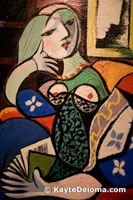 Pablo Picasso, another of the collector’s favorites, dominates the 20th century wing. The museum has 45 of the artist’s sketches, paintings and sculptures. Not all of them are on display at the same time, but the selected works show the diversity of styles Picasso used before developing his signature Cubism. Woman with a Book (1932), one of Picasso’s most recognizable Cubist pieces is presented next to his straightforward pre-cubist oil-and-chalk-on-canvas Bust of a Woman (1923).
Pablo Picasso, another of the collector’s favorites, dominates the 20th century wing. The museum has 45 of the artist’s sketches, paintings and sculptures. Not all of them are on display at the same time, but the selected works show the diversity of styles Picasso used before developing his signature Cubism. Woman with a Book (1932), one of Picasso’s most recognizable Cubist pieces is presented next to his straightforward pre-cubist oil-and-chalk-on-canvas Bust of a Woman (1923).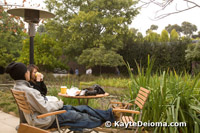 There is a Garden Café and Sculpture Garden at the back of the Main Level. Most of the massive sculptures around the pond are by French artist, Aristide Maillol, including the figure of a woman apparently washing her hair in a river. Unfortunately, they positioned the woman with her hair facing the pond; it’s not in the best position to be viewed from the path.
There is a Garden Café and Sculpture Garden at the back of the Main Level. Most of the massive sculptures around the pond are by French artist, Aristide Maillol, including the figure of a woman apparently washing her hair in a river. Unfortunately, they positioned the woman with her hair facing the pond; it’s not in the best position to be viewed from the path.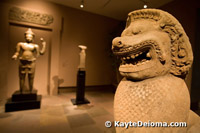 While the paintings and sculptures on the main level have brought the Norton Simon its greatest renown, the lower level also holds abundant treasures. Norton Simon was fascinated by Indian and other South and Southeast Asian antiquities. His collection ranges from the pious to the playful to the erotic as depicted in copper miniatures, cast bronze figures and carved stone statues and architectural features. Gods and goddesses, celestial dancers and amorous couples are the predominant themes. A separate Asian Sculpture Garden is accessible from the Asian galleries on the Lower Level.
While the paintings and sculptures on the main level have brought the Norton Simon its greatest renown, the lower level also holds abundant treasures. Norton Simon was fascinated by Indian and other South and Southeast Asian antiquities. His collection ranges from the pious to the playful to the erotic as depicted in copper miniatures, cast bronze figures and carved stone statues and architectural features. Gods and goddesses, celestial dancers and amorous couples are the predominant themes. A separate Asian Sculpture Garden is accessible from the Asian galleries on the Lower Level.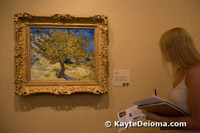 If you have time, take in an orientation film or two in the 300-seat theater. The Art of Norton Simon is a 30 minute film about Norton Simon and his passion for Art. Sister Wendy at the Norton Simon Museum is a delightful tour by the black-robed art scholar, Sister Wendy, of some of the museum’s most famous pieces. The hour-long program created for PBS has been broken into three 20-minute segments for viewing at the museum.
If you have time, take in an orientation film or two in the 300-seat theater. The Art of Norton Simon is a 30 minute film about Norton Simon and his passion for Art. Sister Wendy at the Norton Simon Museum is a delightful tour by the black-robed art scholar, Sister Wendy, of some of the museum’s most famous pieces. The hour-long program created for PBS has been broken into three 20-minute segments for viewing at the museum.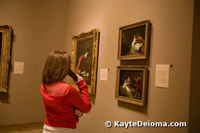 time, so you may not find every painting in the brochure or the videos on the wall when you visit. The paintings are organized by period and by country of origin. The galleries on the main level are all single corridors, so you can go down one side and come back the other and see everything. A self-guided audio tour is available to guide you through the highlights of the exhibit. You dial in the number next to a painting to listen to commentary about it, so you can make the tour as long or short as you like, depending on which pieces you want to hear more about.
time, so you may not find every painting in the brochure or the videos on the wall when you visit. The paintings are organized by period and by country of origin. The galleries on the main level are all single corridors, so you can go down one side and come back the other and see everything. A self-guided audio tour is available to guide you through the highlights of the exhibit. You dial in the number next to a painting to listen to commentary about it, so you can make the tour as long or short as you like, depending on which pieces you want to hear more about.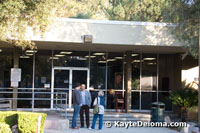 just occasionally look up at the moon and the stars, a tour of the Jet Propulsion Laboratory (JPL) in Pasadena will give you a new perspective on the night sky. It’s not something you can decide to do at the last minute on a rainy day because you have to make reservations in advance, so don’t wait for the rain to make your plans. If it does rain, you’ll need your umbrella for walking between the buildings.
just occasionally look up at the moon and the stars, a tour of the Jet Propulsion Laboratory (JPL) in Pasadena will give you a new perspective on the night sky. It’s not something you can decide to do at the last minute on a rainy day because you have to make reservations in advance, so don’t wait for the rain to make your plans. If it does rain, you’ll need your umbrella for walking between the buildings.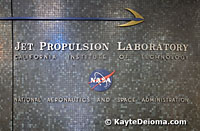 In the 1930s, a group of students at the California Institute of Technology (Caltech) were experimenting with rocket propulsion. After the explosions and the smell got them banned from campus, they found a spot a few miles away in a dry river bed at the foot of the San Gabriel Mountains to set off their rockets, and the Jet Propulsion Laboratory was born. The growing success of their rocket experiments brought in government funding and contracts with the U.S. Army.
In the 1930s, a group of students at the California Institute of Technology (Caltech) were experimenting with rocket propulsion. After the explosions and the smell got them banned from campus, they found a spot a few miles away in a dry river bed at the foot of the San Gabriel Mountains to set off their rockets, and the Jet Propulsion Laboratory was born. The growing success of their rocket experiments brought in government funding and contracts with the U.S. Army.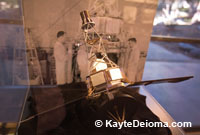 In January 1958, following on the heels of Russia’s Sputnik satellite launch, JPL created the first U.S. satellite to be sent into space, the Explorer I. When the National Aeronautics and Space Administration (NASA) was formed later that year, JPL was invited to be the lead research and development arm for NASA robotics. Since then, JPL has sent over 50 space exploration robots out into our solar system and currently has 17 research modules from satellites to the Mars Exploration Rovers, sending back signals to scientists on the ground. The oldest of these, the Voyager 1 and 2 have been in space since their 1977 launch and continue to send back signals from the far reaches of the universe.
In January 1958, following on the heels of Russia’s Sputnik satellite launch, JPL created the first U.S. satellite to be sent into space, the Explorer I. When the National Aeronautics and Space Administration (NASA) was formed later that year, JPL was invited to be the lead research and development arm for NASA robotics. Since then, JPL has sent over 50 space exploration robots out into our solar system and currently has 17 research modules from satellites to the Mars Exploration Rovers, sending back signals to scientists on the ground. The oldest of these, the Voyager 1 and 2 have been in space since their 1977 launch and continue to send back signals from the far reaches of the universe.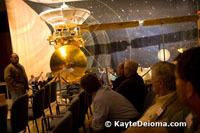 small theater with large scale models of some of the more famous space exploration robots on display. The guide gives a brief history of JPL before showing a short film that gives a refresher course on the solar system and some of the highlights of what the research vessels have found. Exciting footage puts you in the control room with JPL scientists and engineers as the Mars Rover lands successfully on the red planet.
small theater with large scale models of some of the more famous space exploration robots on display. The guide gives a brief history of JPL before showing a short film that gives a refresher course on the solar system and some of the highlights of what the research vessels have found. Exciting footage puts you in the control room with JPL scientists and engineers as the Mars Rover lands successfully on the red planet.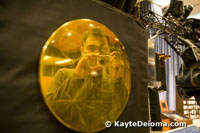 Voyager, with its golden record on the front, conceived by Carl Sagan. You can also hear a piece of the recording which contains greetings in 60 languages, bits of music and other cultural sounds of the 70s, and see the 117 pictures that were chosen to represent humanity on earth. In case there is intelligent life out there somewhere, pictographic instructions are etched on the record cover describing how to play it. Other models on display include the Mars Global Surveyor, the Mars Odyssey Orbiter, and the Cassini Spacecraft andHuygens Probe, currently circling Saturn and its moon, Titan.
Voyager, with its golden record on the front, conceived by Carl Sagan. You can also hear a piece of the recording which contains greetings in 60 languages, bits of music and other cultural sounds of the 70s, and see the 117 pictures that were chosen to represent humanity on earth. In case there is intelligent life out there somewhere, pictographic instructions are etched on the record cover describing how to play it. Other models on display include the Mars Global Surveyor, the Mars Odyssey Orbiter, and the Cassini Spacecraft andHuygens Probe, currently circling Saturn and its moon, Titan.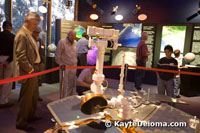 Next to the theater is the JPL Museum. A full scale Mars Exploration Rover and many smaller scale models of spacecraft are on display. Globes of planets and moons indicate named features that have been documented by the space explorers. While older members of our group honed in on trying to find their houses on a large satellite map of Southern California, James, who looked to be about 5, raced from model to globe to model calling to his friend, “Thunder, you gotta see this!”
Next to the theater is the JPL Museum. A full scale Mars Exploration Rover and many smaller scale models of spacecraft are on display. Globes of planets and moons indicate named features that have been documented by the space explorers. While older members of our group honed in on trying to find their houses on a large satellite map of Southern California, James, who looked to be about 5, raced from model to globe to model calling to his friend, “Thunder, you gotta see this!”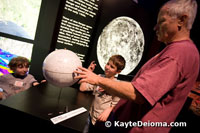 Large scale photos of the birth and death of stars, taken from the Hubble Space Telescope, adorn one wall. A sample of Silica Aerogel, also known as “solid blue smoke” has a certificate from the Guinness Book of World Records for being the lightest solid substance in the world. In the next museum display, they project a neat little light show on blocks of the smoky substance. In space, among other things, they use it to capture particle samples.
Large scale photos of the birth and death of stars, taken from the Hubble Space Telescope, adorn one wall. A sample of Silica Aerogel, also known as “solid blue smoke” has a certificate from the Guinness Book of World Records for being the lightest solid substance in the world. In the next museum display, they project a neat little light show on blocks of the smoky substance. In space, among other things, they use it to capture particle samples.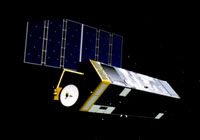 From the video, you know that this nerve center of operations is filled with wall to wall scientists and engineers when it’s time for a launch or landing. It looks a lot like other NASA control rooms you see in the news and the movies for the launch of manned space missions. On an ordinary day, most of the three rows of consoles in the main room and more work stations in a windowed area off to the side are unoccupied. On our visit, five people are at their monitors, keeping track of all the unmanned spacecraft in the universe.
From the video, you know that this nerve center of operations is filled with wall to wall scientists and engineers when it’s time for a launch or landing. It looks a lot like other NASA control rooms you see in the news and the movies for the launch of manned space missions. On an ordinary day, most of the three rows of consoles in the main room and more work stations in a windowed area off to the side are unoccupied. On our visit, five people are at their monitors, keeping track of all the unmanned spacecraft in the universe.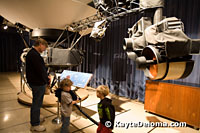 Using flat planets stuck on a carpet wall, we get a lesson in space distances. The comparison that most resonates with me is the time it takes to send and receive messages. It takes 1.5 seconds for a message to reach the moon, which is a mere 384,000 miles from Earth. It takes over 14 hours for a message to travel to the Voyager 1 spacecraft. At 10 billion miles from Earth and counting, it is the most distant human creation in the universe. Traveling at about 39,000 miles per hour, Voyager 1 should reach the outer boundary of our solar system within the next 10 years. Hopefully its 1977 nuclear batteries will still be running to tell us what’s out there.
Using flat planets stuck on a carpet wall, we get a lesson in space distances. The comparison that most resonates with me is the time it takes to send and receive messages. It takes 1.5 seconds for a message to reach the moon, which is a mere 384,000 miles from Earth. It takes over 14 hours for a message to travel to the Voyager 1 spacecraft. At 10 billion miles from Earth and counting, it is the most distant human creation in the universe. Traveling at about 39,000 miles per hour, Voyager 1 should reach the outer boundary of our solar system within the next 10 years. Hopefully its 1977 nuclear batteries will still be running to tell us what’s out there.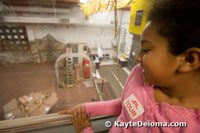 glassed-in walkway you can look down on a Mars simulation room where a replica of the Mars Rover is used to test out program directions before they are sent to the Rovers on Mars. If there is a problem with the Spirit or Opportunity Rovers, the problem is recreated and solved with the replica Rover and then the solution is uploaded to the research vehicles on Mars. It takes about 15 minutes to send a signal to Mars – a lot closer than the Voyager 1.
glassed-in walkway you can look down on a Mars simulation room where a replica of the Mars Rover is used to test out program directions before they are sent to the Rovers on Mars. If there is a problem with the Spirit or Opportunity Rovers, the problem is recreated and solved with the replica Rover and then the solution is uploaded to the research vehicles on Mars. It takes about 15 minutes to send a signal to Mars – a lot closer than the Voyager 1.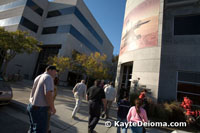 f you’re traveling with a group of 10 or more, special tours can be arranged outside of the Wednesday public tours. JPL also holds an annual two-dayOpen House in May where the scientists come out of their labs and bring their projects to demonstrate, from Mars Exploration Rovers and other robots to thermal imaging equipment, solar telescopes and space suits. There are also monthly lectures on space and technology-related topics that are open to the public.
f you’re traveling with a group of 10 or more, special tours can be arranged outside of the Wednesday public tours. JPL also holds an annual two-dayOpen House in May where the scientists come out of their labs and bring their projects to demonstrate, from Mars Exploration Rovers and other robots to thermal imaging equipment, solar telescopes and space suits. There are also monthly lectures on space and technology-related topics that are open to the public.